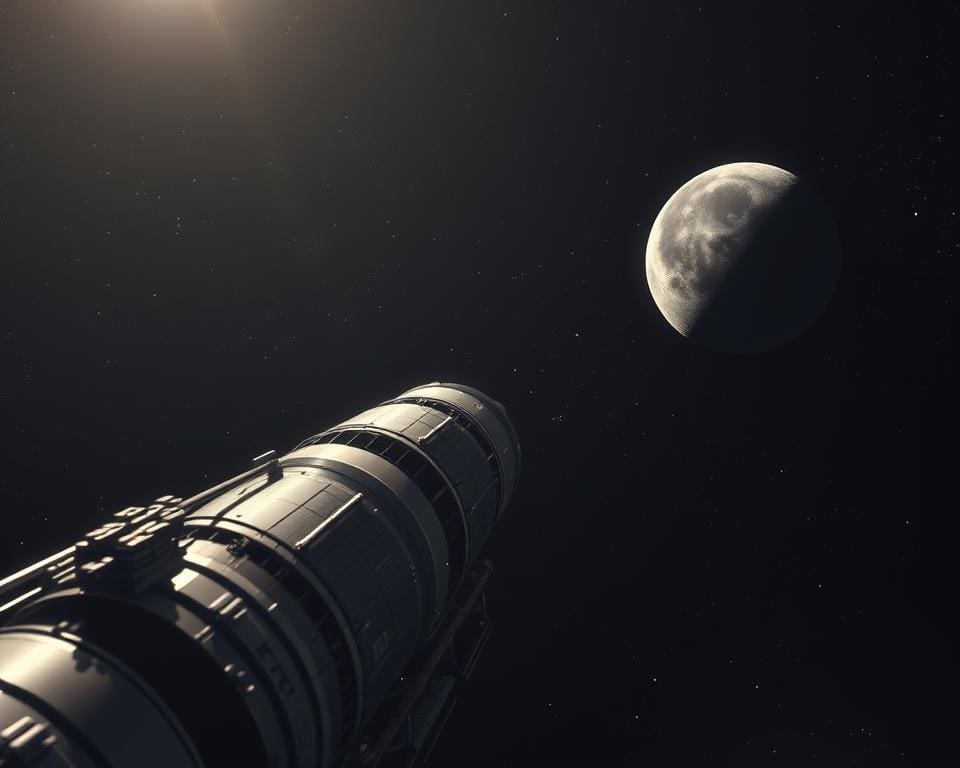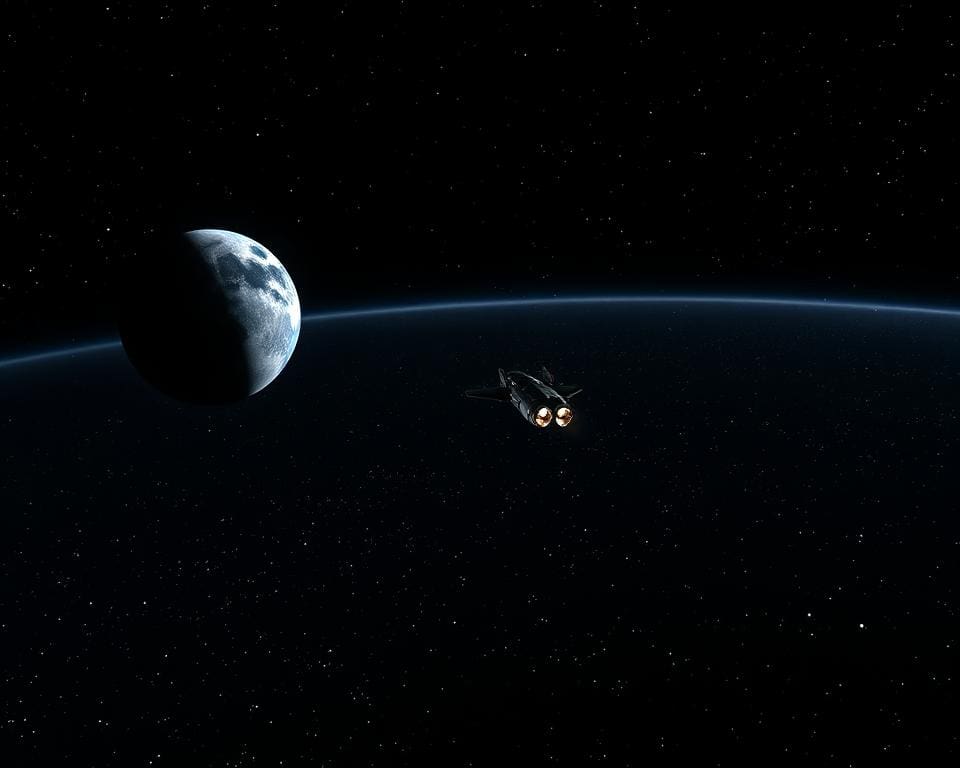The exploration of the Moon is a remarkable testament to human ingenuity and ambition. As we gaze up at our celestial neighbour, many ponder the question: How long to travel to the Moon? The average lunar travel duration is typically around three days, influenced by various mission specifics and spacecraft technology. Understanding this moon travel time not only ignites our imaginations but also sheds light on the complexities of space exploration. Let’s embark on this journey and appreciate what it truly takes to reach the Moon.
The Journey to the Moon: An Overview
The allure of the moon has captivated humanity for millennia. Ancient civilisations gazed up at the moon’s luminous orb, pondering its mysteries. As technology evolved, so did our capacity for lunar exploration. This evolution features significant milestones that paved the way for the journey to the Moon duration that we envision today.
The Historical Context of Lunar Travel
The quest for lunar understanding accelerated during the Space Race of the late 20th century. The 1969 Apollo 11 mission, conducted by NASA, marked a historic achievement when humans first set foot on the lunar surface. This pivotal moment not only showcased technological advancements but solidified the significance of exploration in human history. Each mission in this race contributed valuable knowledge, shaping our understanding of the lunar environment and influencing future efforts.
Significant Missions to the Moon
A variety of significant missions to the Moon have broadened our knowledge and paved the way for future exploration. Unmanned missions, such as the Soviet Luna programme, provided vital data and samples from the lunar surface. NASA’s Apollo programme not only sent astronauts to the Moon but also aimed to study its geology. The lunar travel duration of these missions varied, highlighting the challenges and triumphs of space exploration. Over time, the knowledge gained from these significant missions to the Moon has become foundational for ongoing and future lunar initiatives.

How Long To Travel To Moon
The time taken to reach the Moon can vary significantly based on various influencing factors. Each lunar mission has its distinct trajectory, mission profile, and spacecraft capabilities that contribute to the overall travel time to the Moon. Understanding these elements provides insight into the complexities involved in planning a successful moon voyage.
Factors Influencing Travel Time
Several key factors impact the moon voyage length, shaping the duration of a lunar journey:
- Trajectory: The path a spacecraft takes to the Moon can be direct or indirect, affecting how quickly it reaches its destination. Direct routes are typically shorter but may require more propulsion power.
- Gravitational Pull: The gravitational forces of both Earth and the Moon play crucial roles. A spacecraft must overcome Earth’s gravity to embark on its journey while also navigating the Moon’s gravitational field.
- Mission Profile: Specific mission objectives dictate the planned speed and timing of manoeuvres, which can lead to variations in travel time to the Moon.
The Role of Spacecraft Technology
Advancements in spacecraft technology have transformed how astronauts travel to the Moon, continuously reducing moon travel time. Integrated systems within modern spacecraft allow for enhanced propulsion, navigation, and communication, paving the way for more efficient missions. For instance, SpaceX’s Starship promises to revolutionise space travel with its cutting-edge specifications.
Typical Moon Travel Duration
The excitement surrounding lunar missions draws attention to the varying durations of these remarkable journeys. By looking at significant examples, one can see how mission designs and spacecraft technology evolve, reshaping the experience of travelling to the Moon.
Comparing Various Space Missions
As we delve into the details, it’s enlightening to consider the moon trip duration of earlier missions like Apollo 11, which accomplished the feat in approximately 76 hours. This journey stands in stark contrast to contemporary missions such as the uncrewed Chandrayaan-2, which approaches lunar exploration with advanced technologies and strategies. Notable missions and their respective durations include:
- Apollo 11: 76 hours
- Apollo 10: 61 hours
- Chandrayaan-2: 48 hours (planned trajectory)
- Artemis missions: projected to further optimise travel time
These comparisons reveal the intricate relationship between mission objectives and spacecraft design when comparing various space missions. The technical advancements in spacecraft enable shorter lunar travel time, enhancing efficiency with each subsequent programme.
Lunar Travel Time, Then and Now
Exploring the shift in travel times from initial endeavours to modern accomplishments emphasises a significant trend of continual improvement. Technological breakthroughs and evolving mission designs have made lunar travel more accessible and realistic, propelling further aspirations for exploration. The anticipation surrounding upcoming missions showcases a landscape vastly different from that of the Apollo era, demonstrating not only the achievements of the past but the exhilarating potential that awaits us in space.
Understanding Moon Travel Speed
As humanity ventures into the vastness of space, understanding moon travel speed becomes essential. The efficiency and success of lunar missions largely depend on the specifications of the spacecraft employed. Each vehicle’s design impacts not only its capability but also the overall moon voyage length.
Different Spacecraft Specifications
The characteristics of various spacecraft play a pivotal role in determining their moon travel speed. When examining the following specifications, one can appreciate how they directly influence the travel time to the Moon:
- Propellant Type: The choice of fuel affects both speed and thrust.
- Engine Design: Advanced propulsion systems can significantly reduce travel duration.
- Total Mass: A lighter spacecraft may achieve higher velocities.
The Science Behind Travel Speed
Understanding the scientific principles governing travel speed is crucial for plotting a successful path to the Moon. Key concepts include:
- Velocity: The rate at which a spacecraft moves influences how quickly it reaches its destination.
- Gravitational Assists: Using the gravity of celestial bodies can help accelerate missions.
- Orbital Mechanics: The laws of motion are essential in calculating optimal flight paths.
These scientific insights are vital for comprehending the complexities involved in planning effective and timely missions to the Moon.
Preparing for a Lunar Voyage
The preparation for a lunar voyage is an intricate and comprehensive process that begins long before the spacecraft leaves Earth. Astronauts undergo extensive training programmes designed to equip them with the skills necessary for the unique challenges they will face during the journey to the Moon duration. These programmes often simulate various lunar environments, enabling crew members to familiarise themselves with the conditions they will encounter, from low gravity to the psychological aspects of extended space travel.
Ensuring the spacecraft is ready for its mission is equally crucial. Engineers and technicians conduct rigorous testing to guarantee every system is functioning perfectly. This includes checking life support systems, navigation tools, and other equipment essential for a successful moon trip duration. The meticulous attention to detail in this phase reflects the understanding that any oversight could jeopardise the entire mission.
Logistical planning also plays a pivotal role in preparation, encompassing everything from food and supplies to scientific instruments that astronauts will use on the lunar surface. Each item must be carefully considered and packed to meet the unique needs of the voyage. By emphasising these preparatory phases, it becomes evident how much dedication and hard work is invested in each lunar mission, inspiring excitement about future journeys to the Moon.









